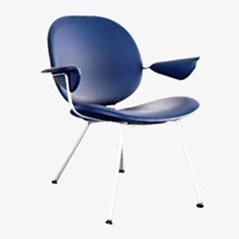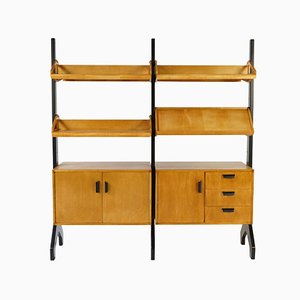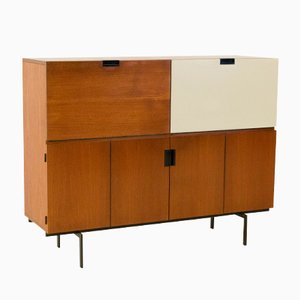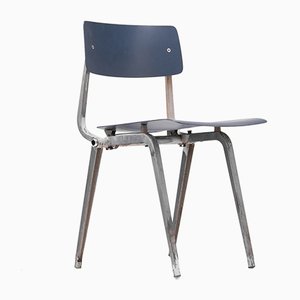How the Dutch went modern in the mid-20th century
In Favor of Function
If you ask international design lovers to think about 20th-century Dutch design, most will likely picture the pioneering objects of the early decades, like De Stijl architect Gerrit Rietveld’s Red Blue Chair (1917) or Bauhaus designer Mart Stam’s cantilevered tubular steel chair (1926). Many will also call to mind the conceptually driven works from Droog, like Tejo Remy’s Rag Chair (1991) or Marcel Wanders’s Knotted Chair (1996), which changed the course of global design in the 1990s. What falls between these bookends, however, is a rich array of modernist products that tend to be overlooked by design history. Remarkably, this underappreciated body of work carries with it the same beloved modernist characteristics applied to American, Scandinavian, and Italian midcentury design—simple, functional, affordable—but perhaps even more so.
Dutch designers and manufacturers in the 1940s, ’50s, and ’60s prided themselves on developing new techniques for mass production to aid the creation of highly rationalized products that conformed to the strictest tenants of modernism: uncomplicated forms, minimal use of materials, practical and easy-to-use designs, and prices tailored for the middle class. This effort resulted in furniture and accessories that were consistently innovative and aesthetically spare, but unfailingly homey.
At the end of World War II, the Netherlands was released from its five-year German occupation, under which modernism was decidedly forbidden and artists were forced to follow oppressive standards if they wished to practice their crafts. In the aftermath of the war, civil liberties were reinstated, but the country had to contend with a number of issues, from rebuilding infrastructure and healing the crippled economy to addressing the intense housing shortage—all exacerbated by the hundreds of thousands of forced labourers and prisoners returning from Germany and Poland and the thousands coming out of hiding. It wasn’t until the early 1950s, with the help of the US Marshall Plan, that the Dutch economy began to recover. Modernist designers eagerly contributed to the recovery effort by encouraging factory production and retail consumption with new products that reflected postwar needs and lifestyles.
In 1946, consumers, businesspeople, and designers joined forces to found the Stichting Goed Wonen (Good Living Foundation), which aimed to address material shortages and improve the quality and comfort of daily life through well-designed, well-made functional domestic products. This organization, which included designers like Friso Kramer, Kho Liang Ie, and Wim Rietveld, was the new embodiment of the prewar “Moral Modernism”—simple, honest, functional design—that emerged as Dutch designers became disenchanted with the aspirational ideals of De Stijl and other ideological movements. After the war, designers retained many of the same ideals but now emphasized the need to reconstruct a war-torn country both economically, through increased manufacturing, and psychologically, through beautiful, well-made goods.
Stichting Goed Wonen preached “good design” through its namesake magazine, which ran from 1948 to 1968, alongside a program of exhibitions and lectures. Thanks to the popularity of these efforts, tens of thousands of people flooded its showrooms seeking decorating advice and inspiration. Goed Wonen gave its stamp of approval to practical designs that lacked superfluous decoration and exemplified economy of material. Cases in point: Cees Braakman’s modular, flat-packed Made to Measure Cabinet System for UMS-Pastoe (1955), J. J. M. Hoogervorst's aesthetically pure Counter Balance Ceiling Lamp for Anvia (1950s), Martin Visser’s minimalist BR02 Sofa Bed for ‘t Spectrum (1958/60), and Wim Rietveld's multipurpose Pyramid Tables and Chairs for Ahrend De Cirkel (1960). Even Edmond Bellfroid’s easy-to-hold, reserved but warm Wilma Tea Service for Mosa was worthy of the foundation’s attention. Ornament was out; clean lines, monochromatic fabrics, and unpretentious utility were in. So even if De Stijl’s philosophies no longer applied in the postwar period, its material objective of geometric shapes and reduction of form endured.
The Dutch also looked outside the Netherlands for inspiration—to Marcel Breuer, Ludwig Mies van der Rohe, and the Bauhaus, as well as various Scandinavian designers and especially Herman Miller and the work of Charles and Ray Eames in the US. Many designers—some even funded by the Dutch government—visited the US in the late 1940s and ’50s, and many more saw foreign design in magazines and exhibitions. Countless Dutch designers were energized by the Eameses’ experimental approach to bent plywood and the modest, clean forms of their LCW and DCW Chairs. The strength of this influence is apparent in myriad 1950s Dutch designs, like Gerrit Rietveld’s Danish Chair for Tomado (1946–1950), Friso Kramer’s Revolt Chair for Ahrend De Cirkel (1953), Cees Braakman’s SB02 Chair for UMS-Pastoe (1952–1954), and various bent plywood designs by Cor Alons for Lutjens/de Boer (1950s). These Dutch designers were not slavishly copying the work of the Eameses, but they were indisputably inspired by the Eameses’ forms, materials, efforts toward mass production, and innovation in manufacturing methods.
Laminated wood, cane, rattan, and metal were all popular postwar domestic and office furnishing materials in the Netherlands. Industrial steel, in particular, was ideally suited to the Goed Wonen rational aesthetic—and Friso Kramer was a trailblazer in steel. While his 1953 Revolt—praised at the 1954 Milan Triennale—might resemble the earlier Eames chairs, his production method was uniquely his own; rather than using pipes, as had become standard, he turned to sheet steel, stamping it, cutting it, bending it, and creating a new, stiff form, distinct from the tubular steel furnishings that proliferated across Europe at the time. When one sits in the Revolt, it has a little give, which allows the sitter to lean back without moving the rest of the chair; its curved form prevents snagged clothing—results achieved through subtle decisions based on close attention to the user’s needs. Kramer created a few iterations on the Revolt design, such as the 1958 Result Chair, as well as some others he made in collaboration with Wim Rietveld. In the Netherlands, the Revolt has become a true icon of modern design, still in production today and widely used by nearly every Dutch schoolchild and office worker.
Wim Rietveld, the youngest son of Gerrit Rietveld, had simple design goals: “well-shaped, solid, practical, and cheap.” His 1407 Chair for Gispen, designed with André Cordemeyer and recipient of a 1954 Milan Triennale gold medal, uses geometric forms not unlike his father’s furniture, as well as the seminal De Stijl palette of red, black, and blue—though not all at once. Martin Visser’s SZ 63 Chair for ‘t Spectrum (1960–1965) even more so resembles the elder Rietveld’s iconic Red Blue Chair in its simplicity and architectonic lines; however, favoring the postwar need for utility and comfort over artistic formalism or philosophical ends, it's upholstered for comfort and invites the user to relax against it, rather than repelling with unforgiving planks of wood.
Unlike many upholstered chairs from the US or Scandinavia, the Dutch versions are cozy without fully encompassing the user. Theo Ruth’s 1953 Penguin Chair for Artifort—low with elegant crisscross legs, its seat and back thickly cushioned with nubby upholstery—is a key example. Dutch design was much too rational, too interested in economy of form, to serve as a womb. Artifort was hugely successful, due in part to Ruth, its first permanent designer, as well as to Indonesian-born Kho Liang Ie, its aesthetic consultant. Liang Ie shepherded to Artifort international designers like Pierre Paulin, who created future icons of Dutch modernism—even when the designers themselves were not Dutch. Paulin’s 1967 No. 577 Chair, better known as the Tongue Chair thanks to its quirky shape, demonstrates Pop Art influences and anticipates postmodernism and the imminent move away from rationalism. His new method of stretching an elastic fabric over foam and tubular steel, also used in his Mushroom and Globe Chairs, was a simple and cost-effective technique both in production and for the user: the cover zips down one side for practical cleaning, and the chair admits many postures.
The desire for “good” design that was economical, functional, and comfortable in line with Goed Wonen’s ideals led to the austere, unadorned yet highly livable forms in much of Dutch midcentury modernism. Even so, just as designers a generation before became disenchanted with their predecessors’ views, the strict guidelines of the Stichting Goed Wonen began to be questioned as early as 1960 and were increasingly defied throughout that decade and the next. Functionalism would be out, replaced by fun, whimsy, contradictions, and questioning. A new era had clearly begun, but nonetheless, Dutch midcentury modernism has endured the waves of fashion. Even if historians haven't yet canonized the makers of midcentury Dutch design like Bovenkamp, Galvanitas, Hala, Fristho, Raak, and Wébé, lovers of industrial-style interiors have ensured these names will live on.
* With special thanks to the brands and organizations that provided archival images for this story: Ahrend, Anvia, Artifort, Stichting Gispen Collectie, Nationaal Archief, Pastoe, and Spectrum. Also thanks to Cassina and Droog. To see a model Goed Wonen room, visit the Van Eesterenmusuem in Amsterdam.
-
Text by
-
Rebecca McNamara
Rebecca is museum professional and art, design, and material culture historian specializing in the 19th and 20th centuries. She is coauthor of A Token of Elegance: Cigarette Holders in Vogue (Officina Libraria, 2015) and author of the e-book Widows Unveiled: Fashionable Mourning in Late Victorian New York (Cooper Hewitt Museum DesignFile series, 2016). Follow her on Twitter @artdesignlust.
-





